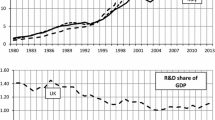Abstract
This paper studies the interaction between information aggregation and investment cycles with investments exhibiting strategic complementarity. The composition of information aggregation varies across different phases of cycles, which in turn affects the course of investment cycles. The phases of cycles are history dependent for informational reasons, and changes in phases depend on the growth rate of aggregate investment: a slowdown in growth is interpreted as bad news and a slowdown in downturn is considered as good news. A small structural change in low cost investments can have a large effect on the pattern of cycles. Investment cycles might be characterized by sudden crashes and slow recoveries.
Similar content being viewed by others
References
Angeletos G.M., Werning I.: Crises and prices: information aggregation, multiplicity and volatility. Am Econ Rev 96, 1721–1737 (2006)
Angeletos G.M., Hellwig C., Pavan A.: Dynamic global games of regime change: learning, multiplicity, and timing of attacks. Econometrica 75, 711–756 (2007)
Avery C., Zemsky P.: Multidimensional uncertainty and herd behavior in financial markets. Am Econ Rev 88, 724–748 (1998)
Banerjee A.: A simple model of herd behavior. Q J Econ 107, 797–817 (1992)
Bikhchandani S., Hirshleifer D., Welch I.: A theory of fads, fashions, customs and cultural changes as information cascades. J Political Econ 100, 992–1026 (1992)
Caplin A., Leahy J.: Business as usual, market crashes, and wisdom after the fact. Am Econ Rev 84, 548–565 (1994)
Chamley C.: Coordinating regime switches. Q J Econ 114, 869–905 (1999)
Chamley C.: Dynamic speculative attacks. Am Econ Rev 93, 603–621 (2003)
Chamley C., Gale D.: Information revelation and strategic delay in a model of investment. Econometrica 62, 1065–1085 (1994)
Clements M.P., Smith J.: The performance of alternative forecasting methods for SETAR models. Int J Forecast 13, 463–475 (1997)
Cooper R., John A.: Coordinating coordination failures in Keynesian models. Q J Econ 103, 441–463 (1988)
Feng H., Liu J.: A SETAR model for Canadian GDP: non-linearities and forecast comparisons. Appl Econ 35, 1957–1964 (2003)
Hodrick R., Prescott E.: Post-War U.S. business cycles: an empirical investigations. J Money Credit Banking 29, 1–16 (1997)
Gale D.: Dynamic coordination games. Econ Theory 5, 1–18 (1995)
Giannitsarou, C., Toxvaerd, F.: Recursive global games. University of Cambridge working paper (2007)
Jehiel P., Moldovanu B.: Efficient design with interdependent valuations. Econometrica 69, 1237–1259 (2001)
Jeitschko T., Taylor C.: Local discouragement and global collapse: a theory of coordination avalanches. Am Econ Rev 91, 208–224 (2001)
Kondratieff, N.D.: Die langen Wellen der Konjunktur. Archiv für Sozialwissenschaft und Sozialpolitik 56, 573–609 (1926)
Levin D., Peck J.: Investment dynamics with common and private values. J Econ Theory 143, 114–139 (2008)
Morris S., Shin H.S.: Unique equilibrium in a model of self-fulfilling currency attacks. Am Econ Rev 88, 587–597 (1998)
Neftci S.: Are economic time series asymmetric over business cycles. J Political Econ 92, 307–328 (1984)
Nieuwerburgh S.V., Veldkamp L.: Learning asymmetries in real business cycles. J Monet Econ 53, 753–772 (2006)
Oyama D.: Booms and slumps in a game of sequential investment with the changing fundamentals. Jpn Econ Rev 55, 311–320 (2004)
Peck, J., Yang, H.: Investment cycles, strategic delay, and self-reversing cascades, OSU working paper (2007)
Potter S.: A nonlinear approach to U.S. GNP. J Appl Econom 10, 109–125 (1995)
Schumpeter, J.A.: Business Cycles: A theoretical, historical, and statistical analysis of the capitalist process. New York and London: McGraw-Hill (1939)
Steiner J.: Coordination cycles. Games Econ Behav 63, 308–327 (2008)
Tiao G.C., Tsay R.S.: Some advances in nonlinear adaptive modelling in time series. J Forecast 13, 109–131 (1994)
Tong, H.: On a threshold model. In: Chen, C.H. Pattern Recognition and Signal Processing, Amsterdam: Sijhoff and Noordoff (1995)
Veldkamp L.: Slow boom, sudden Crash. J Econ Theory 124, 230–257 (2005)
Vives X.: Information and Learning in Markets. Princeton University Press, New Jersey (2008)
Zeira J.: Informational cycles. Rev Econ Stud 61, 31–44 (1994)
Author information
Authors and Affiliations
Corresponding author
Additional information
I would like to thank Russell Cooper, Robert De Jong, Bill Dupor, Pok-sang Lam, Lixin Ye, and especially two anonymous referees for helpful discussions and valuable comments.
Rights and permissions
About this article
Cite this article
Yang, H. Information aggregation and investment cycles with strategic complementarity. Econ Theory 43, 281–311 (2010). https://doi.org/10.1007/s00199-009-0467-8
Received:
Accepted:
Published:
Issue Date:
DOI: https://doi.org/10.1007/s00199-009-0467-8




